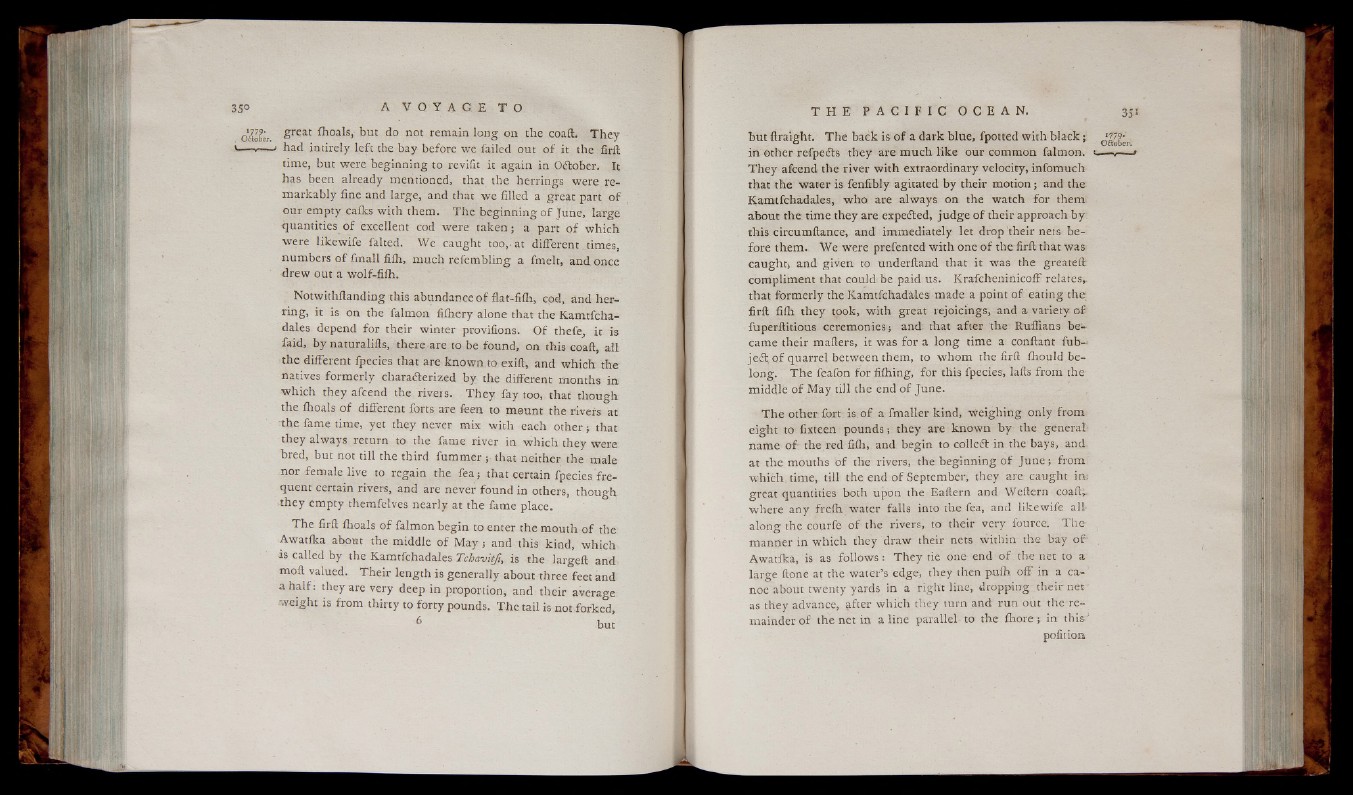
oaZ&r S reat fl10a^si but do not remain long on the coaft. T h e y
>— ^ ' had intirely left the bay before we failed out o f it the firft
time, but were beginning to revifit it again in Odober. It
has been already mentioned, that the herrings were remarkably
fine and large, and that we filled a great part o f
our empty calks with them. T he beginning o f June, large
quantities o f excellent cod were ta k e n ; a part o f which
were likewife falted. We caught too,, at different times,
numbers o f fmall filh, much refembling a fmelt, and once
drew out a wolf-fiih.
Notwithftanding this abundance o f flat-filh, cod, and herring,
it is on the falmon fifhery alone that the Kamtfcha-
dales depend for their winter provifions. O f thefe, it is
faid, by naturalifts, there are to be found, on this coaft, a ll
the different fpecies that are known to exift, and which the
natives formerly characterized by the different months in
w hich they afcend the rivers. T h e y fay too, that though
the fhoals o f different forts are feen to mount the rivers at
the fame time, yet they never mix with each o th e r ; that
they always return to the fame river in w hich they weEe
bred, but not till the third fum m e r ; that neither the male
nor female live to regain the fea ; that certain fpecies frequent
certain rivers, and are never found in others, though
-they empty themfelves nearly at the fame place.
The firft fhoals o f falmon b egin to enter the mouth o f the
Awatfka about the middle o f M a y ; and this kind, which
as called by the Kamtfchadales Tchavitji, is the largeft and
moft valued. T heir length is generally about three feet and
a h a lf: they are very deep in proportion, and their average
w e igh t is from thirty to forty pounds. T h e tail is not .forked,
6 but
but ftraight. T h e back is o f a dark blue, fpotted with b l a c k 0'^^’r
in other refpeds they are much like our common falmon. —v—
T h e y afcend the river with extraordinary velocity, infomuch
that the water is fenfihly agitated by their motion; and the
Kamtfchadales, who are always on the watch for them
about the time they are expected, ju d g e o f their approach by
this circumftance, and immediately let drop their nets before
them. We were prefented with one o f the firft that w as
caught, and given to underftand that it was the greateft
compliment that could be paid us. Krafcbeninicoff relates,,
that formerly the Kamtfchadales made a point o f eating the;
firft fifh they took, with great rejoicings, and a variety o f
fuperftitious ceremonies; and that after the Ruffians became
their mailers, it was for a long time a conftant fu b -
jed , o f quarrel between them, to whom the firft fhould belong.
T h e feafon for fifhing, for this fpecies, lafts from the
middle o f May till the end o f June.
T h e other fort is o f a fmaller kind, w e igh in g only from
e ight to fixteen p ound s ; they are kn own b y the general
name o f the red filh, and begin to co lled in the bays, and.
at the mouths o f the rivers, the beginning o f June; from
which time, till the end o f September, they are caught in:
great quantities both upon the Eaftern and Weftern coaft;.
where any freih water falls into the fea, and likewife. all
along the courfe o f the rivers, to their very fource. T h e ,
manner in which they draw their nets within the bay oft-
Awatfka, is as fo llow s : They tie one end o f the net to a
large ftone at the water’s edge, they then pufh o ff in a canoe
about twenty yards in a right line, dropping-their net
as they advance, after which they turn and run out the remainder
o f the net in a lin e parallel to the fh o r e ;; in this'
pofition